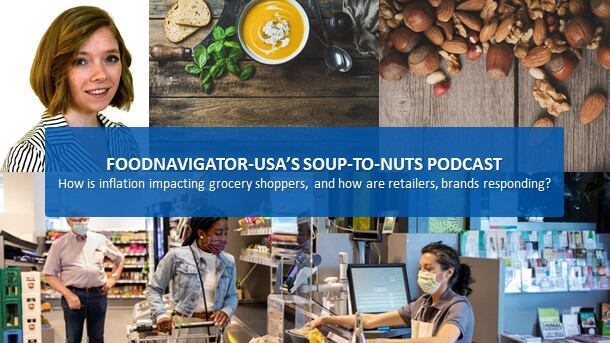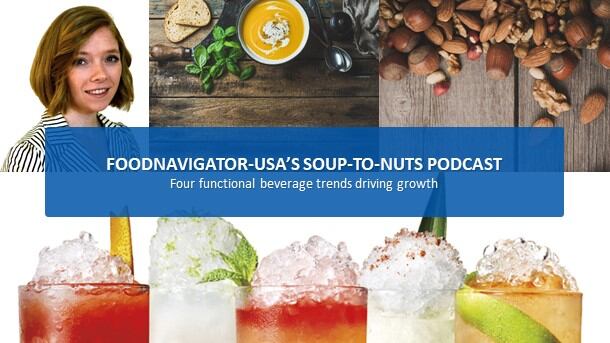Over the past year, many CPG companies have raised prices at least once – and more often multiple times – as the cost of goods, as measured by the producer price index updated last week by the Bureau of Labor Statistics, soared to a staggering 11.2% year-over-year.
So far, consumers appear to be absorbing these higher prices with the Census Bureau’s monthly retail spending report released last week showing US retail and food service sales in March rising 6.9% from a year ago and grocery sales specifically up 9.5% for the year.
But for how much longer will consumers accept and absorb rising prices? And how should food manufacturers and grocers, which have gone to extreme lengths to protect consumers from the full brunt of inflation so far, be preparing for ongoing increases in inflation and potential shifts in shopping?
In this episode of FoodNavigator-USA’s Soup-To-Nuts podcast, Leslie Sarasin, the president and CEO of FMI – The Food Industry Association, shares how inflation, supply chain challenges, the pandemic and other factors are impacting consumers’ perceptions of price and product availability and their shopping habits. Pulling data from the recently published first part in a six-part US Grocery Shopper Trends report, conducted by FMI and The Hartman Group, Sarasin shines a light on which categories and channels are gaining and losing sales as consumers respond to these macro trends, and strategies for stakeholders to seize opportunities hidden within these challenges.
Inflation, supply chain challenges aren’t going away any time soon
While juggling inflation, supply chain challenges and ongoing elevated consumer demand for food at home is a complicated challenge for industry, Sarasin suggests the current climate might not be as grim as it appears at first blush.
“As we head into the second quarter of the year, what we’re continuing to see is that the industry is grappling with inflation, of course, we do have some complicated supply chain challenges that developed during the pandemic that we’re trying to resolve and smooth out a little bit, and then, of course, we have this record setting consumer demand for food at home. And so, all these things that are happening at the same time have really affected how we operate as an industry,” Sarasin said.
For example, the industry has made strides in ensuring the health and safety of employees and shoppers throughout the pandemic and is taking measures to shield consumers from inflation by keeping prices as low as possible.
As a result, she said, even though overall inflation has gone up 8.5% in March from a year ago, FMI days shows household spending on groceries has increased only about 4% to $148 per week so far this year, and weekly grocery spending still remains lower than the $161 per week spent during the height of the pandemic.
“So, there’s good news in some of these numbers,” she said.
Inflation’s uneven impact on consumers poses challenges
While the actual increase in dollar spend might not be as high as some economic indicators suggest, FMI’s study found how consumers perceive and experience current inflation differs significantly across socio-economic groups and their response varies accordingly.
“We do see a lot of differences in how shoppers are behaving and how they’re being impacted by some of these changes,” Sarasin said.
She explained that while most shoppers indicate they are spending more at the grocery store, the impact is more notable among urban and more affluent shoppers.
She also noted that consumers might be “misidentifying the timing of some of their increased spending,” with the increases that occurred earlier in the pandemic feeling smaller than the more current ones because the increases now convinced with other economic challenges, such as at the gas pump.
Consumers also are spending more on groceries now than pre-pandemic because they are eating at home more to reduce the risk of COVID-19 exposure at restaurants and many are trading up to higher quality items as a way to treat themselves as they stay home, Sarasin said.
Consumers are looking for savings
Whether the impact of inflation is real or perceived, FMI’s research found consumers are starting to alter their shopping habits to mitigate price increases even as they continue to spend more at the grocery store than they did pre-pandemic.
According to FMI’s 2022 Grocery Shopper Trends Report, 59% of shoppers are looking for deals, 58% are substituting or changing products to save, 48% are changing where or how they buy groceries and 35% are buying more store brands.
In response, Sarasin said many retailers are changing their product mix, providing tools to help consumers cook at home more and stepping up the assortment and quality of their private label products to help ensure shoppers can buy what they need at a price they can afford.
COVID-19 concerns continue to influence shoppers
While inflation has been top of mind in the past week, it is not the only factor swaying shopping behavior. Sarasin explains that the pandemic continues to influence where and how consumers buy groceries, including online.
She explained that FMI found about a third of shoppers are concerned about getting sick from other shoppers at the store, which is down from a peak of nearly two-thirds in April 2020, but that they feel safer visiting stores where there are masking and vaccination requirements.
As such, some are changing where the shop. FMI data shows that supermarkets remain the primary destination for most grocery shoppers, but online is gaining sustained traction and will likely continue to grow.
Channel shifting is keeping prices down
According to FMI’s research, more consumers also are buying groceries from Mass and club stores and fewer from supermarkets. Since 2019, the percentage of shoppers who considered the supermarket their primary channel has dropped from 49% to 40%, while mass grew from 24% to 33% in 2021 before dipping back to 30% in 2022. Club has steadily gained shoppers going from 5% in 2019 to 9% this year.
Sarasin noted that increased competition among these and other channels, like convenience, is helping to keep inflation in check for shoppers as they compete for feet by keeping prices low.
Looking forward, inflation likely will remain a top influencer for where and how consumers shop and what they buy, according to Sarasin who added how long economic pressures last hinges on a variety of factors – some known and some likely not.
“We won’t see much relief from inflationary pressures until at least 2023, and the extent to which that happens sooner rather than later, I think, really is dependent on what other unanticipated obstacles we may experience in the coming months,” such as weather, geopolitical conflicts, labor, transportation logistics, inventory control and more, Sarasin said.
While some of these factors can’t be controlled, FMI is working with stakeholders to manage as best as possible the ones that can. For example, Sarasin said, the trade group is working with legislators and government officials to potentially ease transportation challenges by advocating for more flexibility around who can drive and when. It also is working with the government to provide waivers for certain restrictions and regulations that may hinder reliable access to food.
As FMI does this, it also plans to keep the industry appraised of its efforts and how the food landscape and shoppers’ behaviors are evolving through the ongoing publication of its six-part 2022 US Grocery Shopper Trends series. The Shopper Landscape, from which Sarasin shared insights today, is already available and the remaining five parts will publish over the course of the year. To read the first report, and get updates on when the next five publish, please visit www.FMI.org/GroceryTrends.




